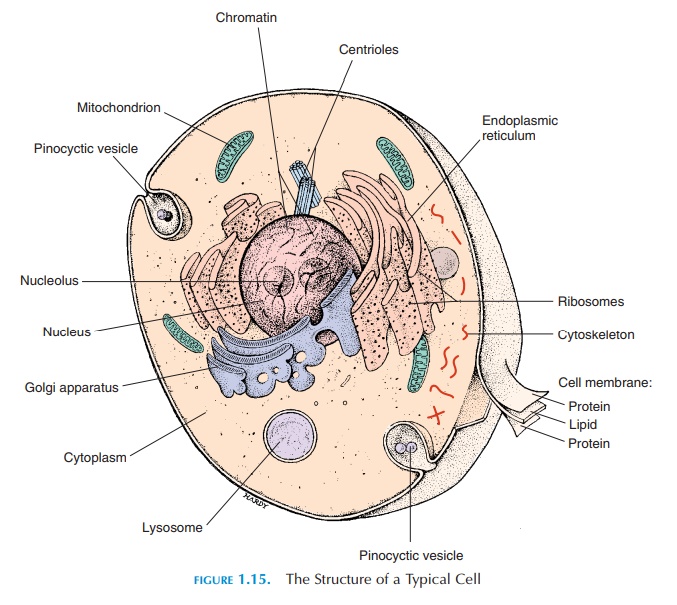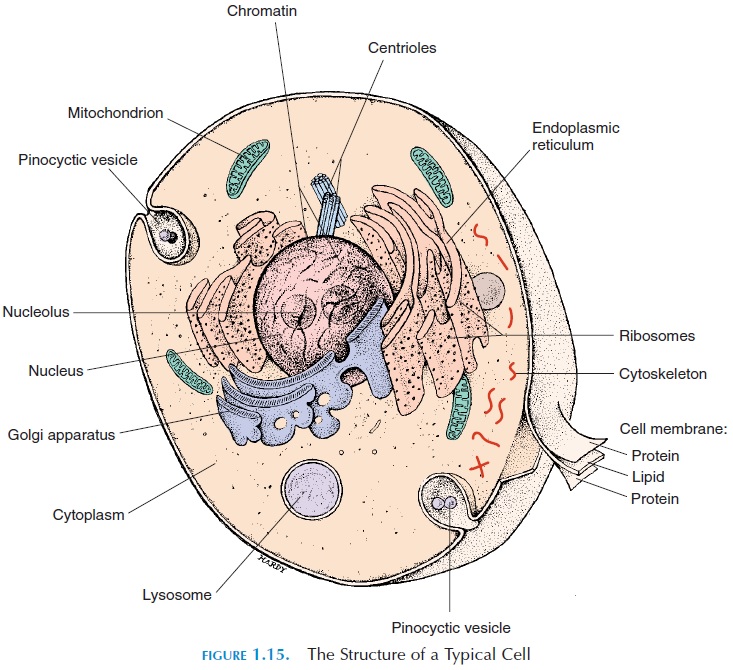Chapter: The Massage Connection ANATOMY AND PHYSIOLOGY : Introduction to Anatomy and Physiology
Organelles

Organelles
The cell has many organelles. Some of the organelles are enclosed in a lipid membrane, separating them from the cytosol; others are in direct contact with the cytosol (Figure 1.15). The membranous organelles in-clude the mitochondria, endoplasmic reticulum, the Golgi apparatus, lysosomes, and peroxisomes.
The nonmembranous structures include the cy-toskeleton, the microvilli, centrioles, cilia, fla-gella, and ribosomes.

Mitochondria
The mitochondria are double-membrane structures, which may be long and slender or short and fat. The number of mitochondrion vary from cell to cell, from red blood cells, having no mitochondria, to liver cells, which are packed with them. The presence of mito-chondria indicates the demand for energy by specific cells.
The inner membrane of the mitochondria is thrown into folds to increase the surface area. The in-side of the mitochondria contains the enzymes re-quired for breaking down nutrients to liberate energy for cellular function; 95% of the ATP requirements are provided by mitochondrial activity.
Endoplasmic Reticulum
The endoplasmic reticulum, as the term suggests, is a network of intracellular membranes (which are in the form of tubes and sacs) that is connected to the nuclear membrane. It contains enzymes and partici-pates in protein and lipid synthesis. Some endoplas-mic reticulum appear smooth—smooth endoplasmic reticulum—while others appear rough as a result of the presence of ribosomes (discussed later).
The function of the endoplasmic reticulum varies from cell to cell. The rough endoplasmic reticulum helps manufacture, process, and sort proteins. Smooth endoplasmic reticulum helps manufacture fats and steroids. In muscle cells, it stores the cal-cium required for muscle contraction. In liver cells, it contains enzymes that help detoxify harmful agents such as drugs and alcohol.
Golgi Apparatus (Golgi Complex)
The Golgi apparatus appears as flattened membrane disks known as saccules. If considered similar to a factory, endoplasmic reticulum serves as the packag-ing center of the cell. Chemicals manufactured by the endoplasmic reticulum enter the Golgi complex where they are processed, sorted, and packaged in secretory vesicles ready for dispatch to the outside of the cell, or for storage inside the cell as storage vesi-cles. Secretions, such as hormones and enzymes, are packaged by this structure.
Lysosomes
Lysosomes are vesicles filled with digestive enzymes. The lysosomes are manufactured in the Golgi appa-ratus. The lysosomes enzymes are activated when they fuse with damaged organelles or other vesicles containing contents to be destroyed. On fusion, the enzymes become activated and digest the contents. Substances that can be recycled diffuse back into the cytosol. Unwanted contents are expelled into the ex-tracellular fluid by exocytosis. In sperm cells, lysoso-mal enzymes are secreted outside and help the sperm penetrate the ovum.
Peroxisomes
Peroxisomes are similar to lysosomes, except they help detoxify substances, such as alcohol and hydro-gen peroxide, that are produced by the cell. In this way, peroxisomes protect the cell from the harmful effects of toxic substances.
Cytoskeleton
The cytoskeleton is actually a framework of proteins located inside the cell that gives the cell its flexibility and strength. The cytoskeleton is in the form of fila-ments(threadlike structures) and tubules (micro-tubules). The filaments help anchor organelles inside the cell, as well as anchor the cells to surrounding ar-eas. Tubules help maintain the shape of the cell and help transport substances within the cell.
Microvilli
Microvilli are small fingerlike projections of the cell membrane that increase the surface area. They are found in those cells involved in absorbing substances from the extracellular fluid. Unlike the processes oc-curred by the cell membrane in endocytosis, the mi-crovilli are more stable and are anchored to the cy-toskeleton of the cell. The microvilli present on the surface of intestinal cells increase the surface area for absorption by 20%.
The Centrosome
The centrosome is a structure located close to the nu-cleus. It consists of the pericentriolar area, which is composed of protein fibers and centrioles. The cen-trioles are two, short, cylindrical structure composed of microtubules. They are only found in those cells capable of dividing. Muscle cell, neurons, mature red blood cells, and cardiac muscle cells—all cells not ca-pable of multiplying—lack centrioles. The centriole is important at the time of cell division to separate DNA material.
Cilia
Cilia are projections from the cell membrane found in certain cells, such as those in the respiratory tract. Cilia have nine pairs of microtubules, surrounding a central pair They move rhythmically in one direction and move mucus and other secretions over the cell surface.
Flagella
Flagella (singular, flagellum) can be considered longer cilia. Rather than moving the fluid over the cell surface like the cilia, flagella help move the cell in the surrounding fluid. A good example of a cell with flagellum is the sperm cell of the testis.
Ribosomes
Ribosomes are tiny organelles that manufacture pro-teins. They may be fixed to the endoplasmic reticu-lum (rough endoplasmic reticulum) or float freely in the cytosol.
Related Topics